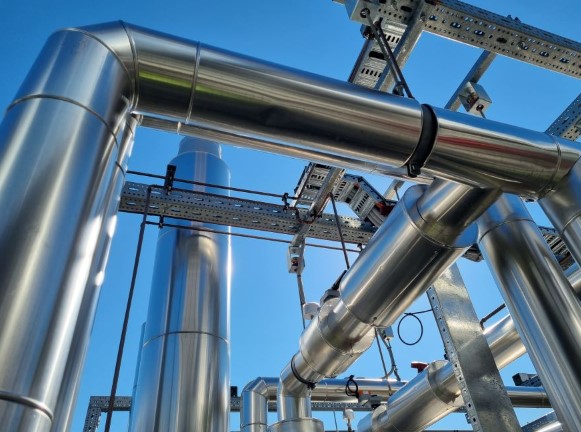Choosing the right material for piping insulation in Alberta is a critical decision that can significantly impact the efficiency, safety, and longevity of industrial operations. Given Alberta’s harsh weather conditions, which range from frigid winters to warm summers, it’s essential to select an insulation material that can withstand these extremes. At G & R Insulating, we understand the complexities involved in this choice, and with over two decades of experience in Western Canada’s oil and gas sector, we are well-equipped to guide you through the process. In this blog post, we will explore the best materials for piping insulation in Alberta, examining their properties, benefits, and suitability for the unique demands of this region.
Importance of Piping Insulation
Piping insulation plays a crucial role in maintaining the efficiency and safety of industrial systems. It helps prevent heat loss, reduce energy consumption, protect pipes from freezing in winter, and minimize the risk of condensation and corrosion. Proper insulation also enhances the overall performance of the piping system, ensuring that fluids within the pipes remain at the desired temperature.
Factors to Consider When Choosing Insulation Material
Selecting the appropriate insulation material involves several considerations, including thermal conductivity, durability, resistance to moisture, ease of installation, and cost. In Alberta, where temperatures can be extreme, the material’s ability to perform under varying conditions is particularly important. Here are the key factors to consider:
- Thermal Conductivity: Low thermal conductivity ensures better insulation.
- Durability: The material should withstand physical and environmental stress.
- Moisture Resistance: Prevents insulation degradation and corrosion.
- Fire Resistance: Important for safety in industrial settings.
- Cost-Effectiveness: Balancing performance and budget constraints.
Fiberglass Insulation
Fiberglass is one of the most commonly used materials for piping insulation due to its excellent thermal insulating properties and cost-effectiveness. It is made from fine strands of glass and can withstand temperatures up to 1000°F. Fiberglass is non-combustible, resistant to moisture, and relatively easy to install. However, it requires protective jacketing to prevent damage and maintain performance.
Advantages of Fiberglass Insulation
- Excellent thermal resistance
- Non-combustible
- Resistant to moisture and mold
- Cost-effective
Drawbacks of Fiberglass Insulation
- Requires protective jacketing
- Can be irritating to the skin and lungs during installation
Mineral Wool Insulation
Mineral wool, also known as rock wool or slag wool, is another popular choice for piping insulation. It is made from molten rock or industrial waste and offers superior fire resistance and sound absorption. Mineral wool can withstand temperatures up to 1200°F and has excellent thermal properties. It is also resistant to water, making it suitable for use in damp environments.
Advantages of Mineral Wool Insulation
- High-temperature resistance
- Excellent fire resistance
- Good sound absorption
- Water-resistant
Drawbacks of Mineral Wool Insulation
- More expensive than fiberglass
- Requires careful handling to avoid skin irritation
Foam Glass Insulation
Foam glass is a cellular glass insulation material known for its high compressive strength and impermeability to moisture. It is ideal for use in environments where water resistance is crucial. Foam glass can operate at temperatures ranging from -450°F to 900°F, making it suitable for extreme conditions. Its non-combustible nature adds an extra layer of safety for industrial applications.
Advantages of Foam Glass Insulation
- Impervious to moisture and vapors
- High compressive strength
- Wide temperature range
- Non-combustible
Drawbacks of Foam Glass Insulation
- Higher cost
- Brittle and can be prone to cracking under mechanical stress
Polyurethane Foam Insulation
Polyurethane foam is a versatile insulation material that offers excellent thermal resistance and low thermal conductivity. It is lightweight, easy to install, and can be sprayed or applied in rigid forms. Polyurethane foam is particularly effective in low-temperature applications and provides good moisture resistance. However, it is combustible and must be used with appropriate fire safety measures.
Advantages of Polyurethane Foam Insulation
- Low thermal conductivity
- Lightweight and easy to install
- Effective in low-temperature environments
- Good moisture resistance
Drawbacks of Polyurethane Foam Insulation
- Combustible
- Can degrade when exposed to UV light
Calcium Silicate Insulation
Calcium silicate is a rigid, high-temperature insulation material often used in industrial applications. It can withstand temperatures up to 1200°F and provides excellent thermal and mechanical properties. Calcium silicate is also resistant to chemical corrosion and physical abuse, making it ideal for use in harsh environments.
Advantages of Calcium Silicate Insulation
- High-temperature resistance
- Excellent thermal and mechanical properties
- Resistant to chemical corrosion
- Durable and long-lasting
Drawbacks of Calcium Silicate Insulation
- Higher cost
- Requires precise installation to avoid thermal bridging
Aerogel Insulation
Aerogel is an advanced insulation material known for its extremely low thermal conductivity and high insulating efficiency. It is lightweight and has a high surface area, providing exceptional thermal performance in a thin profile. Aerogel can operate at temperatures from -200°F to 1200°F, making it suitable for a wide range of applications. However, it is one of the most expensive insulation materials available.
Advantages of Aerogel Insulation
- Extremely low thermal conductivity
- Lightweight and thin profile
- Wide temperature range
- Hydrophobic and resistant to moisture
Drawbacks of Aerogel Insulation
- High cost
- Fragile and requires careful handling
Rubber Insulation
Rubber insulation, commonly made from elastomeric foam, offers good thermal resistance and flexibility. It is particularly useful for applications where pipes need to be insulated around bends and fittings. Rubber insulation is also resistant to moisture, mold, and mildew, making it suitable for use in damp environments. However, it has a limited temperature range compared to other materials.
Advantages of Rubber Insulation
- Flexible and easy to install
- Good moisture and mold resistance
- Suitable for complex shapes and fittings
Drawbacks of Rubber Insulation
- Limited temperature range
- Can be more expensive than some other options
Choosing The Right Insulation Material For Alberta
In Alberta, the best material for piping insulation will depend on the specific requirements of the application and the environmental conditions. For instance, fiberglass and mineral wool are excellent choices for their thermal properties and cost-effectiveness. Foam glass and aerogel offer superior moisture resistance and insulating efficiency, ideal for extreme conditions. Polyurethane foam and rubber insulation provide flexibility and ease of installation for more complex systems.
When selecting an insulation material, it is crucial to consider factors such as temperature range, moisture exposure, fire resistance, and budget. Consulting with experts like G & R Insulating can help ensure that you choose the most suitable material for your needs, maximizing the efficiency and lifespan of your piping systems.
Conclusion
Selecting the best material for piping insulation in Alberta is a vital decision that impacts the efficiency, safety, and durability of your industrial operations. With various options available, each with its unique properties and benefits, it’s essential to carefully evaluate your specific requirements and environmental conditions. At G & R Insulating, we bring over two decades of expertise to help you make an informed decision, ensuring your piping systems are well-protected and optimized for performance. Trust us to deliver top-notch insulation solutions that stand up to Alberta’s challenging climate, providing you with peace of mind and enhanced operational efficiency.




